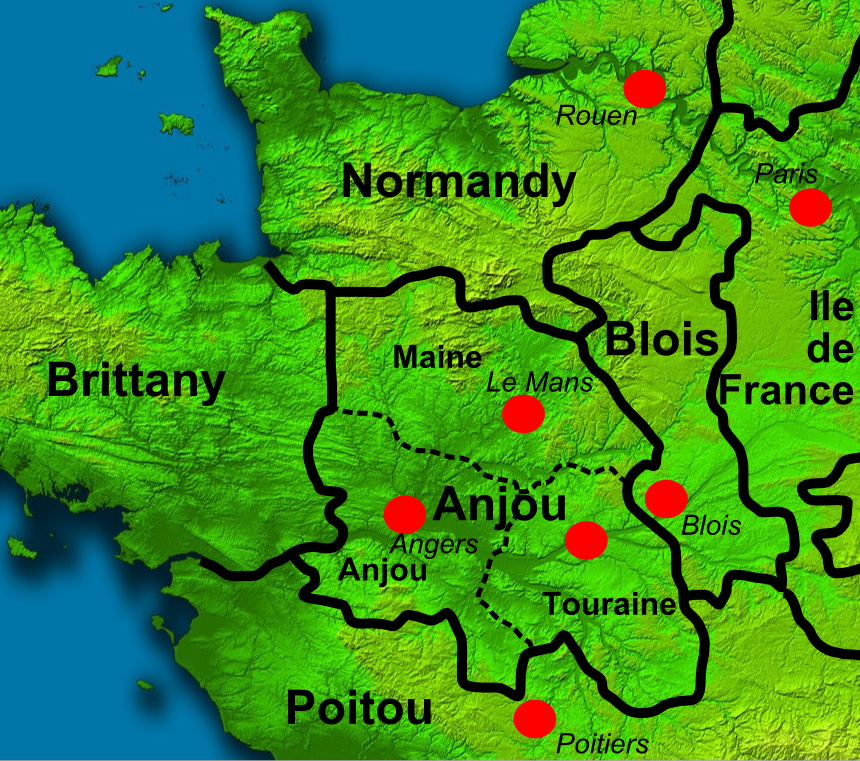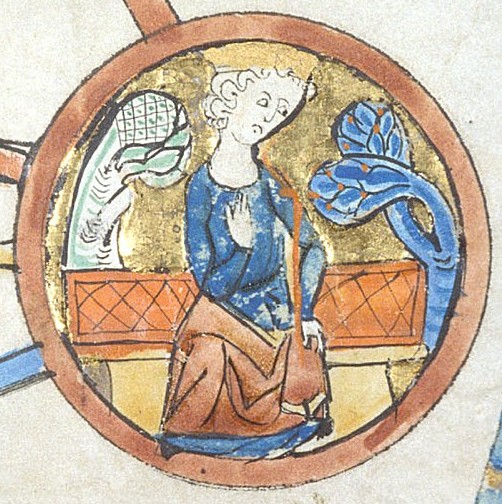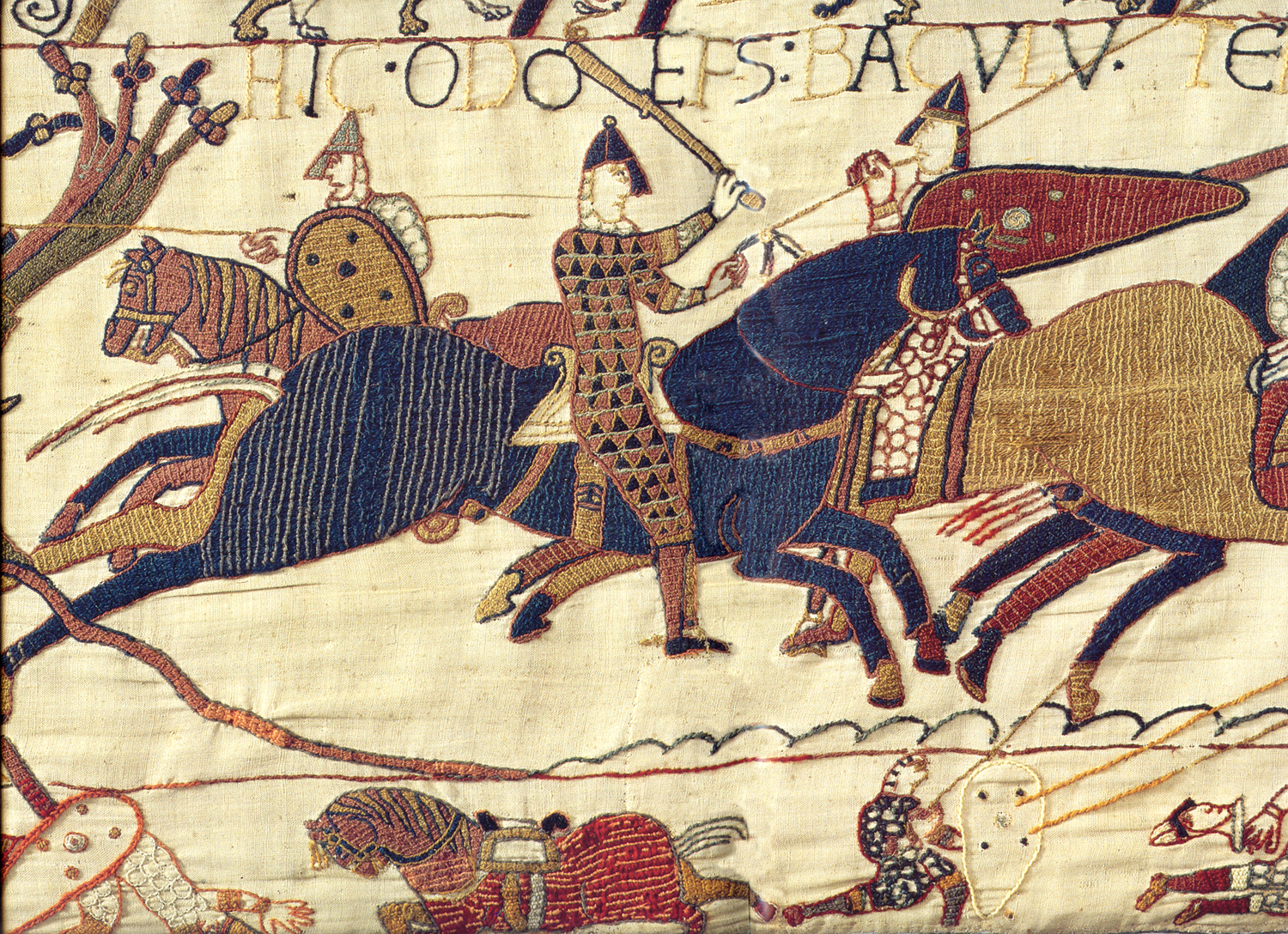|
Geoffrey V Of Anjou
Geoffrey V (24 August 1113 – 7 September 1151), called the Handsome, the Fair (french: link=no, le Bel) or Plantagenet, was the count of Anjou, Touraine and Maine by inheritance from 1129, and also Duke of Normandy by conquest from 1144. His marriage to Empress Matilda, daughter of King Henry I of England, led to the centuries-long reign of the Plantagenet dynasty in England. The name "Plantagenet" was taken from Geoffrey's epithet. Geoffrey's ancestral domain of Anjou gave rise to the name Angevin, and what modern historians name as the Angevin Empire in the 12th century. Early life Geoffrey was the elder son of Fulk V of Anjou and Ermengarde of Maine. Geoffrey received his nickname from the yellow sprig of broom blossom (''genêt'' is the French name for the ''planta genista'', or broom shrub) he wore in his hat. The chronicler John of Marmoutier described Geoffrey as handsome, red haired, jovial, and a great warrior. King Henry I of England, having heard reports ... [...More Info...] [...Related Items...] OR: [Wikipedia] [Google] [Baidu] |
Le Mans
Le Mans (, ) is a city in northwestern France on the Sarthe River where it meets the Huisne. Traditionally the capital of the province of Maine, it is now the capital of the Sarthe department and the seat of the Roman Catholic diocese of Le Mans. Le Mans is a part of the Pays de la Loire region. Its inhabitants are called ''Manceaux'' (male) and ''Mancelles'' (female). Since 1923, the city has hosted the 24 Hours of Le Mans, the world's oldest active endurance sports car race. History First mentioned by Claudius Ptolemy, the Roman city ''Vindinium'' was the capital of the Aulerci, a sub tribe of the Aedui. Le Mans is also known as ''Civitas Cenomanorum'' (City of the Cenomani), or ''Cenomanus''. Their city, seized by the Romans in 47 BC, was within the ancient Roman province of Gallia Lugdunensis. A 3rd-century amphitheatre is still visible. The '' thermae'' were demolished during the crisis of the third century when workers were mobilized to build the city's defe ... [...More Info...] [...Related Items...] OR: [Wikipedia] [Google] [Baidu] |
Le Mans Cathedral
Le Mans Cathedral (French: ''Cathédrale St-Julien du Mans'') is a Catholic church situated in Le Mans, France. The cathedral is dedicated to Saint Julian of Le Mans, the city's first bishop, who established Christianity in the area around the beginning of the 4th century. Its construction dated from the 6th through the 14th century, and it features many French Gothic elements. The cathedral, which combines a Romanesque nave and a High Gothic choir, is notable for its rich collection of stained glass and the spectacular bifurcating flying buttresses at its eastern end. Previous buildings Nothing is known about the form of the original church founded here by St Julian, which was co-dedicated (as with many early cathedrals) to The Virgin and to St Peter. Although there is no archaeological evidence for the building phases prior to 1080, the history of the bishopric and its cathedral is extensively detailed in the 9th century '' Actus pontificum Cenomannis in urbe degentium''. ... [...More Info...] [...Related Items...] OR: [Wikipedia] [Google] [Baidu] |
Henry I Of England
Henry I (c. 1068 – 1 December 1135), also known as Henry Beauclerc, was King of England from 1100 to his death in 1135. He was the fourth son of William the Conqueror and was educated in Latin and the liberal arts. On William's death in 1087, Henry's elder brothers Robert Curthose and William Rufus inherited Normandy and England, respectively, but Henry was left landless. He purchased the County of Cotentin in western Normandy from Robert, but his brothers deposed him in 1091. He gradually rebuilt his power base in the Cotentin and allied himself with William Rufus against Robert. Present at the place where his brother William died in a hunting accident in 1100, Henry seized the English throne, promising at his coronation to correct many of William's less popular policies. He married Matilda of Scotland and they had two surviving children, Empress Matilda and William Adelin; he also had many illegitimate children by his many mistresses. Robert, who invaded from Nor ... [...More Info...] [...Related Items...] OR: [Wikipedia] [Google] [Baidu] |
Broom (shrub)
Genisteae is a tribe of trees, shrubs and herbaceous plants in the subfamily Faboideae of the family Fabaceae. It includes a number of well-known plants including broom, lupine (lupin), gorse and laburnum. The tribe's greatest diversity is in the Mediterranean, and most genera are native to Europe, Africa, the Canary Islands, India and southwest Asia. However, the largest genus, ''Lupinus'', is most diverse in North and South America. ''Anarthrophytum'' and ''Sellocharis'' are also South American and ''Argyrolobium'' ranges into India. Description The Genisteae arose 32.3 ± 2.9 million years ago (in the Oligocene). The members of this tribe consistently form a monophyletic clade in molecular phylogenetic analyses. The tribe does not currently have a node-based definition, but several morphological synapomorphies have been identified: … bilabiate calyces with a bifid upper lip and a trifid lower lip, … the lack of an aril, or the presence of an aril but on the s ... [...More Info...] [...Related Items...] OR: [Wikipedia] [Google] [Baidu] |
Ermengarde Of Maine
Ermengarde or Erembourg of Maine, also known as Erembourg de la Flèche (died 1126), was Countess of Maine and the Lady of Château-du-Loir from 1110 to 1126. She was the daughter of Elias I, Count of Maine, and Mathilda of Château-du-Loire, daughter of Gervais II, Lord of Château-du-Loir. She was grandmother of King Henry II of England In 1109 she married the Angevin heir, Fulk V, called "Fulk the Younger", thereby finally bringing Maine under Angevin control. She gave birth to: * Geoffrey Plantagenet, Count of Anjou (d. 1151) * Elias II, Count of Maine (d. 1151) * Matilda of Anjou (d. 1154), who married William Adelin, the son and heir to Henry I of England. After his death in the '' White Ship'' disaster of 1120, she became a nun and later Abbess of Fontevrault. * Sibylla of Anjou (d. 1165), married in 1121 to William Clito, and then (after an annulment in 1124) to Thierry, Count of Flanders She died in 1126, on either 15 January or 12 October. After her death, F ... [...More Info...] [...Related Items...] OR: [Wikipedia] [Google] [Baidu] |
Fulk V Of Anjou
Fulk ( la, Fulco, french: Foulque or ''Foulques''; c. 1089/1092 – 13 November 1143), also known as Fulk the Younger, was the count of Anjou (as Fulk V) from 1109 to 1129 and the king of Jerusalem with his wife from 1131 to his death. During their reign, the Kingdom of Jerusalem reached its largest territorial extent. Count of Anjou Fulk was born at Angers, between 1089 and 1092, the son of Count Fulk IV of Anjou and Bertrade de Montfort. In 1092, Bertrade deserted her husband, and bigamously married King Philip I of France. Fulk V became count of Anjou upon his father's death in 1109. In the next year, he married Countess Ermengarde of Maine, cementing Angevin control over the County of Maine. Fulk was originally an opponent of King Henry I of England and a supporter of King Louis VI of France, but in 1118 or 1119 he allied with Henry when he arranged for his daughter Matilda of Anjou to marry Henry's son William Adelin. Fulk went on a pilgrimage to Jerusalem in 1119 or 112 ... [...More Info...] [...Related Items...] OR: [Wikipedia] [Google] [Baidu] |
Angevin Empire
The Angevin Empire (; french: Empire Plantagenêt) describes the possessions of the House of Plantagenet during the 12th and 13th centuries, when they ruled over an area covering roughly half of France, all of England, and parts of Ireland and Wales, and had further influence over much of the remaining British Isles. It may be described as an early example of a composite monarchy. The empire was established by Henry II of England, who succeeded his father Geoffrey Plantagenet as Duke of Normandy and Count of Anjou (from which the Angevins derive their name). Henry married Eleanor of Aquitaine in 1152, becoming her royal consort, and inherited his mother Empress Matilda's claim to the English throne, succeeding his rival Stephen, in 1154. Although their title of highest rank came from the Kingdom of England, the Plantagenets held court primarily on the continent at Angers in Anjou, and at Chinon in Touraine. The influence and power of the House of Anjou brought them ... [...More Info...] [...Related Items...] OR: [Wikipedia] [Google] [Baidu] |
Angevin Kings Of England
The Angevins (; "from Anjou") were a royal house of French origin that ruled England in the 12th and early 13th centuries; its monarchs were Henry II, Richard I and John. In the 10 years from 1144, two successive counts of Anjou in France, Geoffrey and his son, the future Henry II, won control of a vast assemblage of lands in western Europe that would last for 80 years and would retrospectively be referred to as the Angevin Empire. As a political entity this was structurally different from the preceding Norman and subsequent Plantagenet realms. Geoffrey became Duke of Normandy in 1144 and died in 1151. In 1152, his heir, Henry, added Aquitaine by virtue of his marriage to Eleanor of Aquitaine. Henry also inherited the claim of his mother, Empress Matilda, the daughter of King Henry I, to the English throne, to which he succeeded in 1154 following the death of King Stephen. Henry was succeeded by his third son, Richard, whose reputation for martial prowess won him the epi ... [...More Info...] [...Related Items...] OR: [Wikipedia] [Google] [Baidu] |
Epithet
An epithet (, ), also byname, is a descriptive term (word or phrase) known for accompanying or occurring in place of a name and having entered common usage. It has various shades of meaning when applied to seemingly real or fictitious people, divinities, objects, and binomial nomenclature. It can also be a descriptive title: for example, Pallas Athena, Phoebus Apollo, Alfred the Great, Suleiman the Magnificent, and Władysław I the Elbow-high. Many English monarchs have traditional epithets: some of the best known are Edward the Confessor, William the Conqueror, Richard the Lionheart, Æthelred the Unready, John Lackland and Bloody Mary. The word ''epithet'' can also refer to an abusive, defamatory, or derogatory phrase. This use as a euphemism is criticized by Martin Manser and other proponents of linguistic prescription. H. W. Fowler complained that "epithet is suffering a vulgarization that is giving it an abusive imputation." Linguistics Epithets are somet ... [...More Info...] [...Related Items...] OR: [Wikipedia] [Google] [Baidu] |
Plantagenet Dynasty
The House of Plantagenet () was a royal house which originated from the lands of Anjou in France. The family held the English throne from 1154 (with the accession of Henry II at the end of the Anarchy) to 1485, when Richard III died in battle. Under the Plantagenets, England was transformed. The Plantagenet kings were often forced to negotiate compromises such as Magna Carta, which had served to constrain their royal power in return for financial and military support. The king was no longer considered an absolute monarch in the nation—holding the prerogatives of judgement, feudal tribute, and warfare—but now also had defined duties to the kingdom, underpinned by a sophisticated justice system. A distinct national identity was shaped by their conflict with the French, Scots, Welsh and Irish, as well as by the establishment of the English language as the primary language. In the 15th century, the Plantagenets were defeated in the Hundred Years' War and beset with social ... [...More Info...] [...Related Items...] OR: [Wikipedia] [Google] [Baidu] |
Henry I Of England
Henry I (c. 1068 – 1 December 1135), also known as Henry Beauclerc, was King of England from 1100 to his death in 1135. He was the fourth son of William the Conqueror and was educated in Latin and the liberal arts. On William's death in 1087, Henry's elder brothers Robert Curthose and William Rufus inherited Normandy and England, respectively, but Henry was left landless. He purchased the County of Cotentin in western Normandy from Robert, but his brothers deposed him in 1091. He gradually rebuilt his power base in the Cotentin and allied himself with William Rufus against Robert. Present at the place where his brother William died in a hunting accident in 1100, Henry seized the English throne, promising at his coronation to correct many of William's less popular policies. He married Matilda of Scotland and they had two surviving children, Empress Matilda and William Adelin; he also had many illegitimate children by his many mistresses. Robert, who invaded from Normandy i ... [...More Info...] [...Related Items...] OR: [Wikipedia] [Google] [Baidu] |
Empress Matilda
Empress Matilda ( 7 February 110210 September 1167), also known as the Empress Maude, was one of the claimants to the English throne during the civil war known as the Anarchy. The daughter of King Henry I of England, she moved to Germany as a child when she married the future Holy Roman Emperor Henry V. She travelled with her husband to Italy in 1116, was controversially crowned in St Peter's Basilica, and acted as the imperial regent in Italy. Matilda and Henry V had no children, and when he died in 1125, the imperial crown was claimed by his rival Lothair of Supplinburg. Matilda's younger and only full brother, William Adelin, died in the '' White Ship'' disaster of 1120, leaving Matilda's father and realm facing a potential succession crisis. On Emperor Henry V's death, Matilda was recalled to Normandy by her father, who arranged for her to marry Geoffrey of Anjou to form an alliance to protect his southern borders. Henry I had no further legitimate children and nomi ... [...More Info...] [...Related Items...] OR: [Wikipedia] [Google] [Baidu] |






